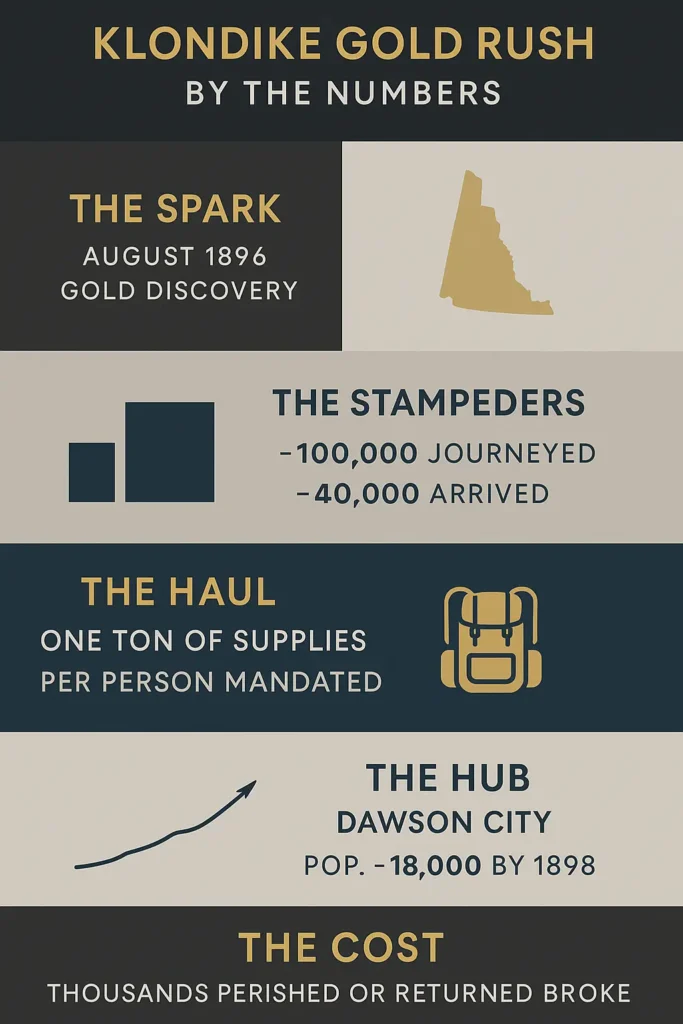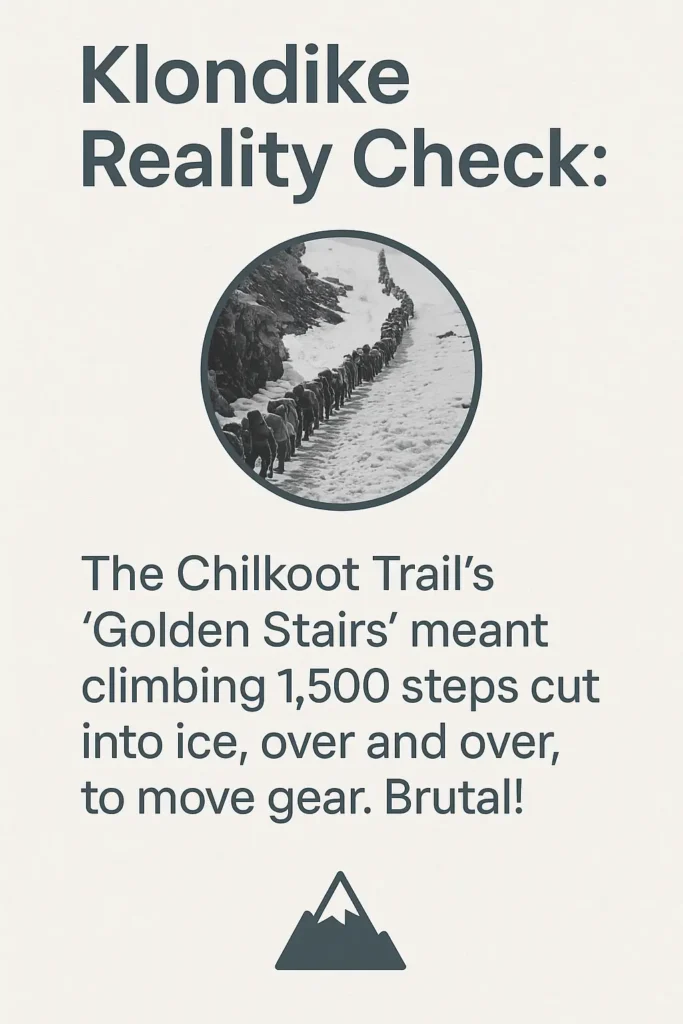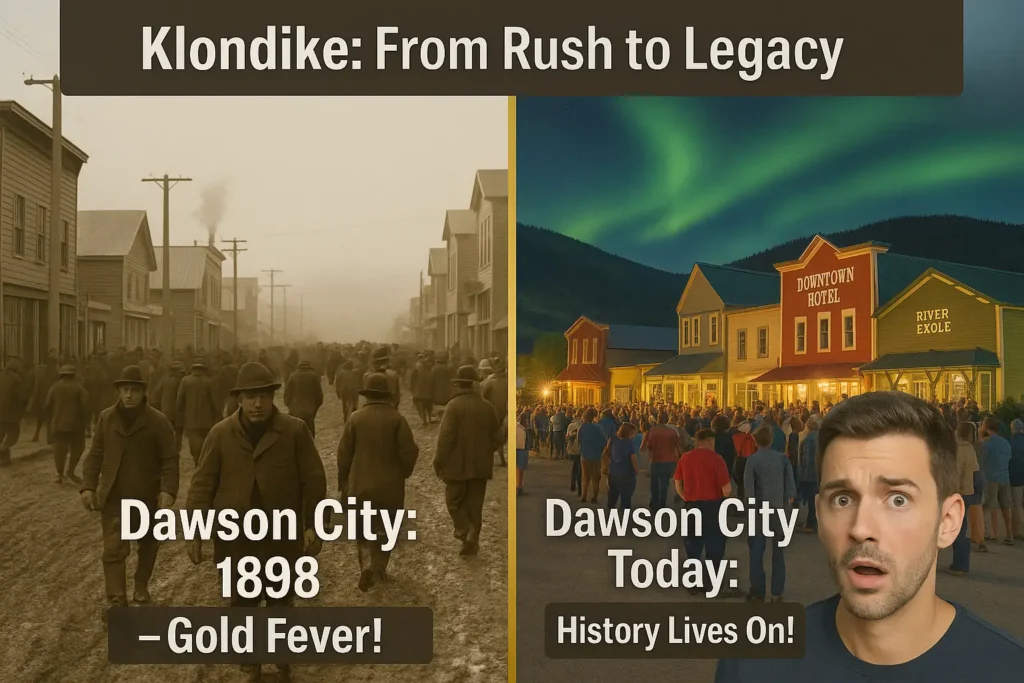The Klondike Gold Rush was a famous time when many people hurried to the Yukon area of Canada to find gold. This happened in the late 1800s after gold was found there.
In a Nutshell: Klondike Gold Rush
- You will learn what started this exciting gold hunt.
- You will find out about the hard journey people faced.
- You will see how it changed the land and people.
- You will understand its lasting story.
Estimated reading time: 5 minutes
Gold rushes can change places very fast. The Klondike Gold Rush is a big example of this. It shows how the dream of finding gold can make people do amazing and hard things. You might wonder what it was really like for those hopeful gold seekers.
What Was the Klondike Gold Rush?
The Klondike Gold Rush began when gold was found on August 16, 1896. Local miners Skookum Jim and his family made the discovery. They found gold near the Klondike and Yukon rivers. News about the gold spread slowly.

It reached big cities like Seattle and San Francisco in early 1897. This news started a huge wave of people going to the Klondike. These people were called prospectors or “stampeders.”
The Stampeders’ Hard Journey
Getting to the Klondike gold fields was very tough. Prospectors faced many dangers.
- Rough Trails: Many traveled through Skagway and Dyea in Alaska. These were main starting points. They had to cross difficult mountain passes. The Chilkoot Trail and White Pass Trail were two common routes. The Chilkoot was very steep. The White Pass was known for being muddy and hard for animals.
- Heavy Supplies: Canada said each person had to bring food for a year. This was to stop people from starving. This meant carrying nearly a ton of supplies.
- Cold Weather: The Yukon has a very cold climate. Prospectors had to deal with freezing temperatures and snow.
- Animal Deaths: Many pack animals died on the trails. The White Pass Trail was sometimes called the “Dead Horse Trail” because so many animals died there. Over 3,000 animals died on this trail.
Life in Dawson City and the Rush’s Peak
Dawson City became the main town of the Klondike Gold Rush. By mid-1898, about 18,000 people lived there. Life was expensive and rough. But, for a short time, it was a busy place full of hope.

Many people opened businesses to support the miners. You could find stores, banks, and saloons. However, the gold rush was unpredictable. Not everyone found gold.
Impacts of the Gold Rush
The Klondike Gold Rush changed many things.
Buy Gold Online: The Smart and Secure Way
Discover the safest and most reliable strategies to buy gold online. Make informed investment decisions and secure your financial future today!
Learn More- Indigenous People: The local Hän people were greatly affected. They were moved to a reserve to make space for the prospectors. Many Hän people died from new diseases and hard living conditions.
- Environment: So many people coming to the area caused problems. Forests were cut down. The ground was eroded. Mining also polluted rivers and soil.
- Economy: A few people got rich. Most did not. But the gold rush helped build up Dawson City and the Yukon region. It also brought more attention to gold mining in Alaska and the Yukon.
The End of the Rush and Its Legacy
By 1899, the Klondike Gold Rush started to slow down. Gold was found in Nome, Alaska. Many prospectors left the Klondike to go there.
Even though it was short, the Klondike Gold Rush is a famous part of history. It is remembered in books, movies, and photos. Jack London wrote famous stories about it. The Klondike Gold Rush National Historical Park in Skagway, Alaska, helps people learn about this time.

It shows the hard work and dreams of the people who went north for gold. You can learn about different techniques of gold mining during the gold rush and the gold rush towns that appeared.
This Klondike Gold Rush Checklist helps you see if you had the basic gear needed by prospectors.
Klondike Supply Check
Stampeders needed about a ton of supplies. Here are a few key items. Could you carry them all?
Conclusion
The Klondike Gold Rush was a short but powerful event. It shows how far people will go for a dream, even with big risks. It left a lasting mark on the Yukon and in stories we still tell today.
- Read Stories: Look for simple books or articles. Jack London’s tales give a feel for the time.
- See Photos: Old photos show what it was really like. Check online museum collections like the University of Washington Libraries Special Collections.
- Visit a Park: If you can, visit a place like the Klondike Gold Rush National Historical Park.
- Think About Choices: Imagine making the hard choices the stampeders faced. It helps you understand their drive.
Your Questions About Klondike Gold Rush Answered (Simply)
What started the Klondike Gold Rush?
Was the Klondike Gold Rush dangerous?
How many people got rich from Klondike?
What did Klondike miners eat?
How long did the Klondike Gold Rush last?
Where was the Klondike Gold Rush?
What challenges did Klondike miners face?


